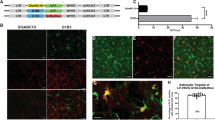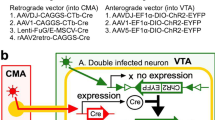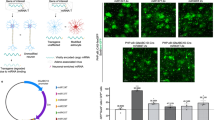Abstract
Human neural progenitor cells (hNPCs) represent an attractive source for cell therapy of neurological disorders. Genetic modification of hNPCs may allow a controlled release of therapeutic proteins, suppress immune rejection, or produce essential neurotransmitters. In search of an effective gene delivery vehicle, we evaluated the efficiency of a recombinant adeno-associated viral (rAAV) vector expressing enhanced green fluorescent protein (CAGegfp). Our study demonstrated that CAGegfp efficiently transduced both proliferating and differentiated hNPCs in vitro. EGFP expression was detected as early as 1 day after exposure to CAGegfp and was detectable for up to 4 months. Following transduction, the growth rate of hNPCs slowed down, but they were still able to differentiate into neurons and glia. Furthermore, CAGegfp-modified hNPCs survived, differentiated and expressed EGFP after transplanting into spinal cord of adult rats. Our results indicated that rAAV vectors might be a useful tool in hNPC-based cell and gene therapy for neurological disorders.
This is a preview of subscription content, access via your institution
Access options
Subscribe to this journal
Receive 12 print issues and online access
$259.00 per year
only $21.58 per issue
Buy this article
- Purchase on Springer Link
- Instant access to full article PDF
Prices may be subject to local taxes which are calculated during checkout







Similar content being viewed by others
References
Gage F.H. . Cell therapy Nature 1998 392: 18 18
Diener P.S., Bregman B.S. . Fetal spinal cord transplants support the development of target reaching and coordinated postural adjustments after neonatal cervical spinal cord injury J Neurosci 1998 18: 763 763
Giovanini M.A. et al. Characteristics of human fetal spinal cord grafts in the adult rat spinal cord: influences of lesion and grafting conditions Exp Neurol 1997 148: 523 523
Fisher L.J. . Neural precursor cells: applications for the study and repair of the central nervous system Neurobiol Dis 1997 4: 1 1
Bjorklund A., Lindvall O. . Cell replacement therapies for central nervous system disorders Nat Neurosci 2000 3: 537 537
Lindvall O. et al. Human fetal dopamine neurons grafted into the striatum in two patients with severe Parkinson's disease. A detailed account of methodology and a 6-month follow-up Arch Neurol 1989 46: 615 615
Reier P.J. et al. Workshop on intraspinal transplantation and clinical application J Neurotrauma 1994 11: 369 369
Barinaga M. . Fetal neuron grafts pave the way for stem cell therapies Science 2000 287: 1421 1421
Whittemore S.R., Eaton M.J., Onifer S.M. . Gene therapy and the use of stem cells for central nervous system regeneration Adv Neurol 1997 72: 113 113
Snyder E.Y. et al. Potential of neural ‘stem-like’ cells for gene therapy and repair of the degenerating central nervous system Adv Neurol 1997 72: 121 121
Shihabuddin L.S., Palmer T.D., Gage F.H. . The search for neural progenitor cells: prospects for the therapy of neurodegenerative disease Mol Med Today 1999 5: 474 474
Snyder E.Y., Macklis J.D. . Multipotent neural progenitor or stem-like cells may be uniquely suited for therapy for some neurodegenerative conditions Clin Neurosci 1995 3: 310 310
Park K.I. et al. Transplantation of neural progenitor and stem cells: developmental insights may suggest new therapies for spinal cord and other CNS dysfunction J Neurotrauma 1999 16: 675 675
Martinez-Serrano A., Bjorklund A. . Immortalized neural progenitor cells for CNS gene transfer and repair Trends Neurosci 1997 20: 530 530
Shihabuddin L.S., Ray J., Gage F.H. . Stem cell technology for basic science and clinical applications Arch Neurol 1999 56: 29 29
McKay R. . Stem cells in the central nervous system Science 1997 276: 66 66
Reynolds B.A., Tetzlaff W., Weiss S. . A multipotent EGF-responsive striatal embryonic progenitor cell produces neurons and astrocytes J Neurosci 1992 12: 4565 4565
Svendsen C.N., Caldwell M.A. . Neural stem cells in the developing central nervous system: implications for cell therapy through transplantation Prog Brain Res 2000 127: 13 13
Svendsen C.N. et al. A new method for the rapid and long-term growth of human neural precursor cells J Neurosci Meth 1998 85: 141 141
Vescovi A.L. et al. Isolation and cloning of multipotential stem cells from the embryonic human CNS and establishment of transplantable human neural stem cell lines by epigenetic stimulation Exp Neurol 1999 156: 71 71
Carpenter M.K. et al. In vitro expansion of a multipotent population of human neural progenitor cells Exp Neurol 1999 158: 265 265
Fricker R.A. et al. Site-specific migration and neuronal differentiation of human neural progenitor cells after transplantation in the adult rat brain J Neurosci 1999 19: 5990 5990
Johansson C.B. et al. Neural stem cells in the adult human brain Exp Cell Res 1999 253: 733 733
Palmer T.D. et al. Cell culture. Progenitor cells from human brain after death Nature 2001 411: 42 42
Roy N.S. et al. In vitro neurogenesis by progenitor cells isolated from the adult human hippocampus Nat Med 2000 6: 271 271
Flax J.D. et al. Engraftable human neural stem cells respond to developmental cues, replace neurons, and express foreign genes Nat Biotechnol 1998 16: 1033 1033
Ostenfeld T. et al. Human neural precursor cells express low levels of telomerase in vitro and show diminishing cell proliferation with extensive axonal outgrowth following transplantation Exp Neurol 2000 164: 215 215
Corti O. et al. A single adenovirus vector mediates doxycycline-controlled expression of tyrosine hydroxylase in brain grafts of human neural progenitors Nat Biotechnol 1999 17: 349 349
Sabate O. et al. Transplantation to the rat brain of human neural progenitors that were genetically modified using adenoviruses Nat Genet 1995 9: 256 256
Villa A., Snyder E.Y., Vescovi A., Martinez-Serrano A. . Establishment and properties of a growth factor-dependent, perpetual neural stem cell line from the human CNS Exp Neurol 2000 161: 67 67
Kaplitt M.G. et al. Long-term gene expression and phenotypic correction using adeno-associated virus vectors in the mammalian brain Nat Genet 1994 8: 148 148
Xiao X., Li J., McCown T.J., Samulski R.J. . Gene transfer by adeno-associated virus vectors into the central nervous system Exp Neurol 1997 144: 113 113
Rabinowitz J.E., Samulski J. . Adeno-associated virus expression systems for gene transfer Curr Opin Biotechnol 1998 9: 470 470
Weihl C. et al. Gene therapy for cerebrovascular disease Neurosurgery 1999 44: 239 239
Berns K.I. . Parvovirus replication Microbiol Rev 1990 54: 316 316
Muzyczka N. . Use of adeno-associated virus as a general transduction vector for mammalian cells Curr Top Microbiol Immunol 1992 158: 97 97
Du B., Wu P., Boldt-Houle D.M., Terwilliger E.F. . Efficient transduction of human neurons with an adeno-associated virus vector Gene Therapy 1996 3: 254 254
Wu P., Phillips M.I., Bui J., Terwilliger E.F. . Adeno-associated virus vector-mediated transgene integration into neurons and other nondividing cell targets J Virol 1998 72: 5919 5919
Niwa H., Yamamura K., Miyazaki J. . Efficient selection for high-expression transfectants with a novel eukaryotic vector Gene 1991 108: 193 193
Monahan P.E., Samulski R.J. . AAV vectors: is clinical success on the horizon? Gene Therapy 2000 7: 24 24
Svendsen C.N. et al. Long-term survival of human central nervous system progenitor cells transplanted into a rat model of Parkinson's disease Exp Neurol 1997 148: 135 135
Suhonen J.O., Peterson D.A., Ray J., Gage F.H. . Differentiation of adult hippocampus-derived progenitors into olfactory neurons in vivo Nature 1996 383: 624 624
Caldwell M.A. et al. Growth factors regulate the survival and fate of cells derived from human neurospheres Nat Biotechnol 2001 19: 475 475
Fisher K.J. et al. Transduction with recombinant adeno-associated virus for gene therapy is limited by leading-strand synthesis J Virol 1996 70: 520 520
Ferrari F.K., Samulski T., Shenk T., Samulski R.J. . Second-strand synthesis is a rate-limiting step for efficient transduction by recombinant adeno-associated virus vectors J Virol 1996 70: 3227 3227
Vincent-Lacaze N. et al. Structure of adeno-associated virus vector DNA following transduction of the skeletal muscle J Virol 1999 73: 1949 1949
Duan D. et al. Circular intermediates of recombinant adeno-associated virus have defined structural characteristics responsible for long-term episomal persistence in muscle tissue J Virol 1998 72: 8568 8568
Sanlioglu S., Duan D., Engelhardt J.F. . Two independent molecular pathways for recombinant adeno-associated virus genome conversion occur after UV-C and E4orf6 augmentation of transduction Hum Gene Ther 1999 10: 591 591
Qing K. et al. Role of tyrosine phosphorylation of a cellular protein in adeno-associated virus 2-mediated transgene expression Proc Natl Acad Sci USA 1997 94: 10879 10879
Forss-Petter S. et al. Transgenic mice expressing beta-galactosidase in mature neurons under neuron-specific enolase promoter control Neuron 1990 5: 187 187
Mizushima S., Nagata S. . pEF-BOS, a powerful mammalian expression vector Nucleic Acids Res 1990 18: 5322 5322
Goldman L.A. . Modifications of vectors pEF-BOS, pcDNA1 and pcDNA3 result in improved convenience and expression Biotechniques 1996 21: 1013 1013
Matsuo K. et al. Expression of the rat calmodulin gene II in the central nervous system: a 294-base promoter and 68-base leader segment mediates neuron-specific gene expression in transgenic mice Brain Res 1993 20: 9 9
Ponnazhagan S., Yoder M.C., Srivastava A. . Adeno-associated virus type 2-mediated transduction of murine hematopoietic cells with long-term repopulating ability and sustained expression of a human globin gene in vivo J Virol 1997 71: 3098 3098
Xiao X., Li J., Samulski R.J. . Efficient long-term gene transfer into muscle tissue of immunocompetent mice by adeno-associated virus vector J Virol 1996 70: 8098 8098
Kearns W.G. et al. Recombinant adeno-associated virus (AAV-CFTR) vectors do not integrate in a site-specific fashion in an immortalized epithelial cell line Gene Therapy 1996 3: 748 748
Duan D., Fisher K.J., Burda J.F., Engelhardt J.F. . Structural and functional heterogeneity of integrated recombinant AAV genomes Virus Res 1997 48: 41 41
Rutledge E.A., Russell D.W. . Adeno-associated virus vector integration junctions J Virol 1997 71: 8429 8429
Ponnazhagan S. et al. Lack of site-specific integration of the recombinant adeno-associated virus 2 genomes in human cells Hum Gene Ther 1997 8: 275 275
Nakai H., Storm T.A., Kay M.A. . Recruitment of single-stranded recombinant adeno-associated virus vector genomes and intermolecular recombination are responsible for stable transduction of liver in vivo J Virol 2000 74: 9451 9451
Malik P. et al. Recombinant adeno-associated virus mediates a high level of gene transfer, but less efficient integration in the K562 human hematopoietic cell line J Virol 1997 71: 1776 1776
Samulski R.J. et al. Targeted integration of adeno-associated virus (AAV) into human chromosome 19 EMBO J 1991 10: 3941 3941
Martinez-Serrano A. et al. Human neural progenitor cells: better blue than green? Nat Med 2000 6: 483 483
Sieber-Blum M. . Growth factor synergism and antagonism in early neural crest development Biochem Cell Biol 1998 76: 1039 1039
Shihabuddin L.S., Horner P.J., Ray J., Gage F.H. . Adult spinal cord stem cells generate neurons after transplantation in the adult dentate gyrus J Neurosci 2000 20: 8727 8727
McDonald J.W. et al. Transplanted embryonic stem cells survive, differentiate and promote recovery in injured rat spinal cord Nat Med 1999 5: 1410 1410
Xiao X., Li J., Samulski R.J. . Production of high-titer recombinant adeno-associated virus vectors in the absence of helper adenovirus J Virol 1998 72: 2224 2224
Zolotukhin S. et al. Recombinant adeno-associated virus purification using novel methods improves infectious titer and yield Gene Therapy 1999 6: 973 973
Snyder R.O., Xiao X., Samulski R.J. . Current Protocols in Human Genetics, pp. 121-12124. Wiley 1996
Acknowledgements
This work was supported by John Sealy Memorial Endowment Fund for Biomedical Research (PW) and the Wellcome Trust (CNS).
Author information
Authors and Affiliations
Rights and permissions
About this article
Cite this article
Wu, P., Ye, Y. & Svendsen, C. Transduction of human neural progenitor cells using recombinant adeno-associated viral vectors. Gene Ther 9, 245–255 (2002). https://doi.org/10.1038/sj.gt.3301646
Received:
Accepted:
Published:
Issue Date:
DOI: https://doi.org/10.1038/sj.gt.3301646
Keywords
This article is cited by
-
Therapeutic potential of human olfactory bulb neural stem cells for spinal cord injury in rats
Spinal Cord (2016)
-
Adeno-associated virus type 4 (AAV4) targets ependyma and astrocytes in the subventricular zone and RMS
Gene Therapy (2005)
-
Light-activated gene transduction of recombinant adeno-associated virus in human mesenchymal stem cells
Gene Therapy (2004)
-
Region-specific generation of cholinergic neurons from fetal human neural stem cells grafted in adult rat
Nature Neuroscience (2002)



